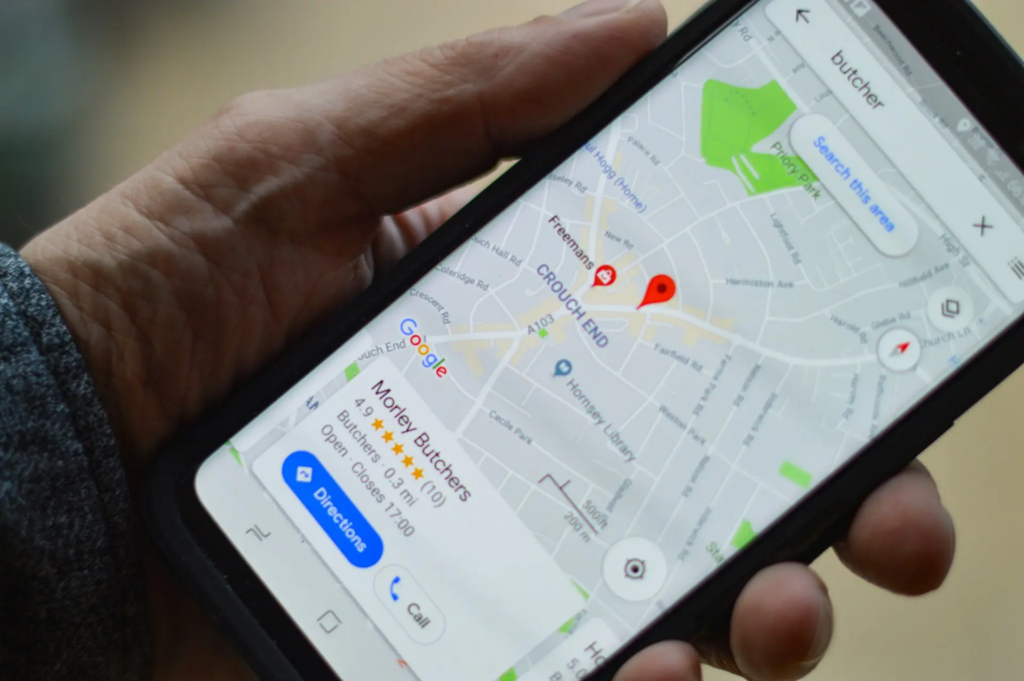Local SEO is a game-changer for businesses targeting customers in their area by optimizing a business’s online presence to show up in local search results—like when someone searches for “therapists near me” or “best coffee shop in San Diego.” 76% of people who search for local businesses on their smartphone visit a store within 24 hours. For businesses that rely on local customers, this can directly impact foot traffic, phone calls, and sales. Local SEO helps businesses improve online visibility and attract the right audience, leading to higher clicks, more customers, and ultimately, a stronger bottom line.
The Foundation: Understanding Local Search and the Buyer's Intent

Local search engine optimization is all about connecting customers with businesses near them. Unlike general online searches, local searches have a geographical intent—people are looking for products, services, or businesses close by. For example, a person searching for “best therapists in San Diego” is likely ready to book an appointment.
When someone conducts a local search, they’re usually further down the marketing funnel, meaning they’re closer to making a decision or purchase. This is why local search is so valuable for businesses—it brings in customers who are actively looking for what you offer.
Statistics show that 78% of mobile local searches result in an offline purchase, and 28% of local mobile searches lead to a store visit within a day. These numbers prove that local SEO is directly tied to revenue growth. By making sure your business shows up when someone nearby is searching for services like yours, you’re more likely to turn those searches into real customers.
To profit from local search, your goal should be to align your online presence with the intent of these local searchers. The better you match their needs, the more likely you are to drive traffic and increase sales.
The Benefits of Local SEO
Local SEO offers numerous benefits for businesses looking to increase their online visibility and attract more local customers. By optimizing their website and online presence for local search, businesses can improve their search engine rankings, drive more traffic to their website, and ultimately, increase their sales and revenue. Local SEO also helps businesses build trust and credibility with potential customers, as well as establish themselves as a local authority in their industry.
Some of the key benefits of local SEO include:
Improved Search Engine Rankings: By targeting local search terms, your business can rank higher in search engine results, making it easier for local customers to find you.
Increased Website Traffic: Optimizing for local search drives more targeted traffic to your website, as people searching for local services are more likely to visit your site.
Higher Conversion Rates: Local customers searching for specific services or products are often ready to make a purchase, leading to higher conversion rates and increased sales.
Enhanced Credibility and Trust: Appearing in local search results and having a well-optimized online presence builds trust with potential customers, making them more likely to choose your business.
Increased Brand Awareness: Consistently showing up in local search results increases your brand’s visibility and reputation within the community.
Cost-Effective Marketing: Local SEO is a cost-effective way to reach potential customers compared to traditional advertising methods, providing a higher return on investment.
By leveraging these benefits, businesses can significantly enhance their online visibility and attract more local customers.
The Core Pillars of Local SEO that Drive Profit
Local SEO isn’t just about ranking higher in search results—it’s about implementing effective local SEO strategies to ensure your business shows up in front of the right people, at the right time. There are a few key strategies that can have a direct impact on your profits. Let’s break them down:
A. Optimizing Your Google Business Profile (GBP): Your Digital Storefront
Your Google Business Profile (GBP) is often the first impression a potential customer has of your business. A fully optimized profile can help you show up in Google’s local pack and on Google Maps, driving more visibility and, ultimately, more customers.
Here’s how to make the most of it:
NAP Consistency: Ensure your Name, Address, and Phone number are accurate and consistent across all online platforms.
Business Description: Write a clear, engaging business description with relevant local keywords that tell customers exactly what you offer.
Photos and Videos: Upload high-quality images or videos of your business, products, or services to capture attention.
Features: Use features like Google Posts to share updates, special offers, and events. Enable messaging so customers can reach you directly.
A well-optimized GBP leads to more visibility, which translates into more clicks, calls, and customers walking through your door.
B. Building a Strong Network of Local Citations
Citations—mentions of your business’s name, address, and phone number (NAP)—are crucial for local SEO. They signal to search engines that your business is legitimate and located in a specific area.
Here’s how to get started:
Find Local Directories: List your business in trusted local directories like Yelp, Yellow Pages, and niche-specific sites.
Maintain NAP Consistency: Ensure your NAP is exactly the same across all directories to avoid confusion.
Tools for Citation Building: Use tools like Bright Local to manage your citations and make sure they stay up to date.
Strong citations from reputable sites can improve your business’s local search rankings and help customers find you easily.
To discover the best directories for therapists and how to optimize your profile, click HERE to read our latest blog article.
C. Earning Authoritative Local Backlinks
Backlinks from other trusted local businesses or community websites act as “votes of confidence” for your business. They tell search engines that your business is relevant and authoritative in your area.
How can you earn local backlinks?
Sponsor Local Events: Get involved in local sponsorships or charity events, which can lead to backlinks from event pages.
Partner with Local Businesses: Collaborate with nearby businesses on promotions, events, or content.
Guest Blogging: Write guest posts for local blogs or publications that link back to your site.
Local backlinks improve your search rankings and drive more targeted traffic to your website.
D. Mastering Online Reviews: Your Social Proof and Conversion Catalyst
Online reviews can make or break a business. Positive reviews increase your visibility and trustworthiness, while also boosting your local search rankings. Research shows that businesses with more reviews are more likely to be clicked on in search results.
Here’s how to get the most out of reviews:
Encourage Happy Customers: Ask satisfied customers to leave reviews on platforms like Google, Yelp, or industry-specific sites.
Respond to Reviews: Take the time to respond to both positive and negative reviews. It shows you care about customer feedback.
Highlight Positive Feedback: Feature top reviews on your website or social media to build trust and attract new customers.
When managed properly, online reviews become powerful tools for improving visibility and converting searches into customers.
Content Strategy: Speaking Directly to Your Local Audience

Creating content that speaks directly to your local audience is crucial for improving your local SEO and increasing profits. Your website should be more than just a digital brochure—it should actively engage your local customers by answering their questions, solving their problems, and connecting with their needs.
Local Keyword Research:
Start by researching local keywords using tools like Google Keyword Planner. Look for phrases your target audience is searching for, such as “best personal trainer in San Diego” or “affordable plumbing services near me.” These are the search terms you’ll want to include in your content to ensure it matches what potential customers are looking for.
Localized Content Ideas:
Blog Posts: Write blog posts about local events, news, or topics that are relevant to your community. For example, if there’s a local fair coming up, write a post about how your business will be involved or how it ties into your services.
Local Problem-Solving: Address common problems that your local customers face and show how your business offers the perfect solution.
Optimizing Website Elements:
Make sure your website’s key elements—such as title tags, meta descriptions, and headings—include local keywords. This will help you rank higher for local searches. Also, ensure your “About Us” and contact pages clearly show that you’re a local business to build trust with your audience.
By consistently creating localized content, you’ll attract the right customers and improve your rankings in local search results.
Mobile Optimization: Capturing the "Near Me" Customer

More people are using their phones to search for businesses nearby, which makes mobile optimization crucial for local SEO. If your website isn’t mobile-friendly, you could be losing out on valuable customers.
Responsive Design:
Your website should adjust smoothly to any screen size, ensuring a seamless experience across phones, tablets, and desktops. A responsive design helps keep visitors on your site longer and reduces bounce rates.
Fast Loading Speed:
Mobile users expect websites to load quickly. If your pages are slow, people will click away before they even see what you offer. Tools like Google PageSpeed Insights can help you identify areas for improvement.
Mobile-Friendly Features:
Make sure your “click-to-call” buttons and Google Maps directions are easy to use on mobile. This helps users take immediate action, whether it’s calling you or visiting your store.
Optimizing for mobile will improve your visibility and conversions, especially from people searching “near me.”
Measuring Your Success: Tracking the ROI of Local SEO
To truly understand the impact of your local SEO efforts, you need to track the right metrics. By measuring your results, you can make data-driven decisions that will help grow your business and increase profits.
Key Metrics to Monitor:
Organic Traffic: Check how much organic traffic your website receives from local keywords. Tools like Google Analytics can show which pages are attracting local visitors.
Referral Traffic: Monitor referral traffic from local directories, review sites, or local publications. This can give insight into which platforms are driving the most valuable traffic.
Phone Calls and Form Submissions: Track phone calls and form submissions that come through your site. These are key indicators that your SEO efforts are converting into real leads.
Direction Requests on Google Maps: Keep an eye on how often people request directions to your business from your GBP listing.
Tracking ROI:
To calculate ROI, measure the sales or leads generated from local search and compare them to the costs of your local SEO efforts. Tools like Google Analytics and conversion tracking in Google Ads will help you track this.
By regularly monitoring these metrics, you’ll know what’s working and where to improve for maximum profit.
The Impact of Local SEO on Business Growth
Local SEO can have a significant impact on business growth, particularly for small and medium-sized businesses that rely on local customers. By optimizing their website and online presence for local search, businesses can attract more local customers, increase their sales and revenue, and ultimately, drive business growth.
Some of the ways in which local SEO can impact business growth include:
Increased Online Visibility: Local SEO helps your business appear in local search results, making it easier for potential customers to find you online.
Improved Search Engine Rankings: By targeting local keywords, your business can rank higher in search results, driving more organic traffic to your website.
Higher Conversion Rates: Local customers searching for specific services or products are often ready to make a purchase, leading to higher conversion rates and increased sales.
Enhanced Brand Awareness: Consistently appearing in local search results increases your brand’s visibility and reputation within the community.
Increased Customer Engagement: Local SEO encourages customer interaction through online reviews, social media, and local events, fostering a loyal customer base.
Cost-Effective Marketing: Local SEO is a cost-effective way to reach potential customers compared to traditional advertising methods, providing a higher return on investment.
By focusing on local SEO, businesses can achieve sustainable growth and establish a strong presence in their local market.
Common Local SEO Mistakes to Avoid
While local SEO can be a powerful tool for businesses looking to increase their online visibility and attract more local customers, there are several common mistakes that businesses should avoid. Some of the most common local SEO mistakes include:
Not Optimizing for Local Search Terms: Failing to include relevant local keywords in your website content can prevent your business from appearing in local search results.
Neglecting Google My Business: Not claiming and optimizing your Google My Business listing can result in missed opportunities for visibility and customer engagement.
Ignoring Local Backlinks: Not building high-quality local backlinks can hinder your search engine rankings and online visibility.
Overlooking Local Content: Not creating and optimizing content that speaks directly to your local audience can limit your reach and engagement.
Not Responding to Online Reviews: Ignoring online reviews and feedback can damage your reputation and deter potential customers.
Failing to Track Local SEO Metrics: Not tracking and analyzing local SEO metrics can prevent you from understanding the effectiveness of your efforts and making necessary adjustments.
By avoiding these common mistakes, businesses can ensure that their local SEO efforts are effective and drive real results for their business.
Sustaining Growth: The Long-Term Commitment to Local SEO
Local SEO isn’t a one-time task; it’s an ongoing strategy that requires consistent attention. To maintain growth and continue seeing results, you need to stay up-to-date with trends, algorithm changes, and local competitor activities.
Regularly audit and refine your local SEO strategy. Update your Google Business Profile, refresh your content with new local keywords, and keep building local citations and backlinks. As your local SEO foundation strengthens, your visibility and customer base will grow over time.
Stay proactive, and your local SEO efforts will continue to pay off in the long run.
Conclusion
Local SEO can have a direct and powerful impact on your business’s profitability. By focusing on key strategies like optimizing your Google Business Profile, building local citations, earning backlinks, and creating localized content, you can increase your visibility and attract more customers. Consistently tracking your results and adapting your approach will help you stay ahead of the competition and maintain long-term growth.
At SassandSEO, we offer both DIY SEO courses and full-service SEO agency solutions to help your business thrive online. Ready to improve your SEO? Explore our course or get in touch with our team to boost your website’s performance today.
Frequently Asked Questions (FAQs)
1. What is local SEO?
Local SEO focuses on optimizing your online presence to attract more business from relevant local searches. It helps businesses show up in local search results like Google Maps and local packs.
2. Why is local SEO important for my business?
Local SEO helps you connect with customers near your business, driving more foot traffic and online conversions. It’s a crucial tool for increasing visibility in your local market.
3. How long does it take to see results from local SEO?
Local SEO results typically take 3-6 months to show significant improvements. Patience is key, as ranking improvements require ongoing optimization and consistency.
4. How can I improve my Google Business Profile?
Ensure your business information is accurate, add high-quality photos, and update your hours regularly. Engage with customers by responding to reviews and using Google Posts.
5. Can I handle local SEO on my own?
Yes! With the right tools and guidance, local SEO can be done DIY. Our SEO course offers step-by-step instructions to help you improve your business’s online presence effectively.





